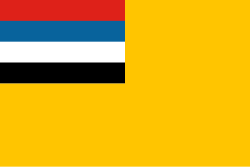Manchukuo
Manchukuo was a puppet state of the Empire of Japan in China and Inner Mongolia from 1932 to 1945. It was first a republic, but in 1934. it became a constitutional monarchy. It had little international recognition and was under the de facto control of Japan. Japan also took Inner Mongolia in 1936 and renamed it Mengjiang in 1936.
State of Manchuria (Manchukuo) (1932–1934) 滿洲國 Empire of (Great) Manchuria (1934–1945) (大)滿洲帝國 | |||||||||
|---|---|---|---|---|---|---|---|---|---|
| 1932–1945 | |||||||||
| Motto: | |||||||||
| Anthem: | |||||||||
 Manchukuo (dark red) within the Empire of Japan (light red) at its furthest extent | |||||||||
| Status | Client state/Puppet state of the Empire of Japan | ||||||||
| Capital | Hsinking (Changchun) (until 9 August 1945) Tonghua (from 9 August 1945) | ||||||||
| Common languages | Japanese Manchu Mandarin Mongolian | ||||||||
| Religion | State Shinto | ||||||||
| Government | One-party constitutional monarchy under an authoritarian-personalist dictatorship | ||||||||
| Chief Executive | |||||||||
• 1932–1934 | Aisin-Gioro Puyi | ||||||||
| Emperor | |||||||||
• 1934–1945 | Aisin-Gioro Puyi | ||||||||
| Prime Minister | |||||||||
• 1932–1935 | Zheng Xiaoxu | ||||||||
• 1935–1945 | Zhang Jinghui | ||||||||
| Legislature | Legislative Council | ||||||||
| Historical era | Interbellum · World War II | ||||||||
• | 18 February 1932 | ||||||||
• | 15 August 1945 | ||||||||
| Area | |||||||||
| 1940 est. | 1,192,081 km2 (460,265 sq mi) | ||||||||
| Population | |||||||||
• 1940 est. | 35,000,000 | ||||||||
| Currency | Manchukuo yuan | ||||||||
| |||||||||
Names
Manchukuo means Manchuria in Japanese 満州国 (Manchukoku). The Mongolians called it (Mongolian : Манеж-Го, Manjugo). The Soviets called it (Russian : Маньчжоу-Го, Man’chzhou-Go). The Chinese called it (Chinese : 满洲国, mǎnzhōuguó). The Koreans called it (Korean : 만주국, Manjugug).
History
Manchuria was the place of the Manchus, including the kings of the Qing dynasty. In 1931, Japan occupied Manchuria after the Mukden Incident. A pro-Japanese government was created one year later, and Puyi, the last Qing emperor, was the nominal regent and later emperor.[1]
Manchukuo's government was removed in 1945 at the end of World War II. The Soviet Union invaded in August 1945[2] and formally transferred the territory to Chinese administration in the following year.
Although the territories came under the jurisdiction of the Nationalist government, the brief Soviet occupation helped make the region a base for the Chinese Communist troops led by Mao Zedong. The People's Liberation Army got Japanese equipment and a strategic advantage against the National Revolutionary Army, led by Chiang Kai-shek.[3]
Manchus were a minority in Manchukuo, and the largest ethnic group were Han Chinese. The number of Koreans increased in Manchukuo, and there were also Japanese, Mongols, White Army Russians, and other minorities. The southern part of the Liaodong Peninsula was ruled by Japan as the Kwantung Leased Territory.
Manchukuo had a Japanese death camp, called Unit 731, where up to half a million died from medical experiments and other causes. That is similar to the Nazi concentration camp of Auschwitz, in German-occupied Poland.
In August 1945 Stalin invaded Manchukuo, Mengjiang, and norhern Korea. America occupied southern Korea since the two large countries had divided Korea into two. The Soviet leader, Joseph Stalin, controlled Manchuria until 1946. The same year, Stalin began to help Mao win the Second Chinese Civil War (1946-1949).
Manchukuo Media
Manchukuo National Anthem 1933-1942 Chinese Korean
Manchukuo National Anthem 1942
The Japan–Manchukuo Protocol signed on 15 September 1932
Puyi (regnal name "Kangde") as emperor of Manchukuo
Shinto shrine in Qiqihar, Heilongjiang, taken prior to 1945
Location of Manchukuo (darker red) within the Greater East Asia Co-Prosperity Sphere, 1939
Hideki Tojo (right) with Nobusuke Kishi, the key architect of Manchukuo during 1935–39, known as the "Showa-era monster"
References
- ↑ Encyclopædia Britannica article on Manchukuo Archived 21 December 2007 at the Wayback Machine
- ↑ C. Peter Chen. "Manchurian Strategic Offensive Operation | World War II Database". World War II Database. Archived from the original on 4 September 2015. Retrieved 10 September 2015.
- ↑ Borisov O. 1977. The Soviet Union and the Manchurian Revolutionary Base (1945-1949). Moscow, Progress Publishers.








